Billions of dollars of gold, silver and emeralds encrust a tiny patch of the Caribbean Sea. In 1708, during the War of Spanish Succession (1701 to 1714), a British Navy warship sailing from Panama sank the 62-gun Spanish galleon known as the San José. This treasure-laden galleon has lain undisturbed off the coast of Cartagena, the fortified city on Colombia’s Caribbean coast, for the last three centuries.
When the wreck of the San José was discovered in 2015 it sparked an international uproar as several countries laid claim on her immensely valuable cargo, dubbed the Holy Grail of shipwrecks. Nevertheless, Colombia’s President Ivan Duque announced that the Colombian Navy (ARC) has sent a high tech robot to a depth of 944.88 metres (3,100 ft) with a high-resolution camera.
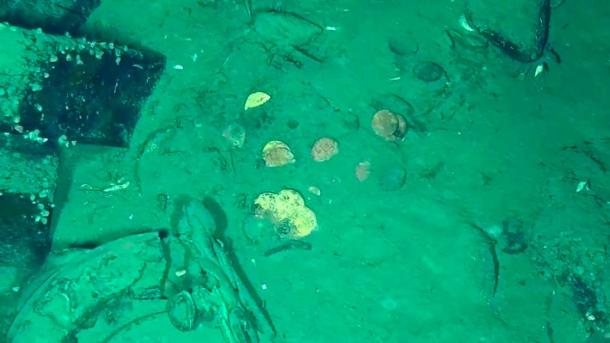
Some gold coins and artifacts visible on the ocean bed from the treasure laden San Jose wreck. ( Presidency of the Republic of Colombia )
Imaging the Sunken Treasures and Cannons of the San Jose Wreck
Scanning the San José’s hull, which has been estimated to contain around 20 billion dollars (£16.7 billion) worth of precious metals, the robotic-diver filmed some of the gold coins and collections of intact crockery. “These are important discoveries that guarantee the protection of the San José Galleon while advancing in what would be a future extraction process, maintaining the unification as a World Heritage Site under our sovereign custody,” stated Duque in Radio Nacional de Colombia .
Colombia’s soon-to-be-replaced President Duque, after the June 19th 2022 general elections, said that the Colombian Navy used high-tech equipment to a series of striking images representing a “level of precision that’s never been seen before.” The robot sent back digital images of gold ingots and coins, and well-preserved crockery.
A report in The Daily Mail explained that, among the intact porcelain crockery, pottery and glass bottles, the robot spied an “intricate Chinese dinner set.” Furthermore, the deep-diving electronic treasure hunter also identified a cannon made in Seville in 1655 AD.
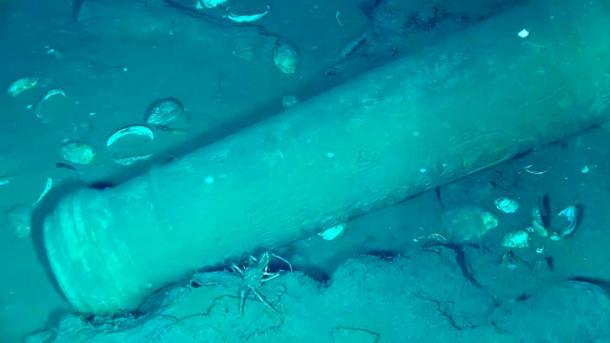
The new underwater images identified a cannon made in Seville in 1644 AD at the San Jose wreck site. ( Presidency of the Republic of Colombia )
During four dives to the San Jose wreck, the deep-sea rover also discovered the rotting hulls of two more ships. The BBC reported that their discovery is testimony not only to the volume of heritage on the bed of the Caribbean Sea, but also to how turbulent this area of water was in the not so distant past. “It is believed that there are more than 1,000 sunken Spanish galleons off the coast of Colombia alone,” reported Al Jazeera .
The two ships, a colonial-era galleon and a schooner, have been dated to Colombia’s war for independence from Spain which it achieved in 1819, thanks to Simón Bolívar’s campaign to liberate New Granada. Colombian Admiral Gabriel Perez said these two ships, and other discoveries in the same area, are being scheduled for further archaeological exploration. However, the exact location is being kept private for Colombia is renowned for its high-level looting.
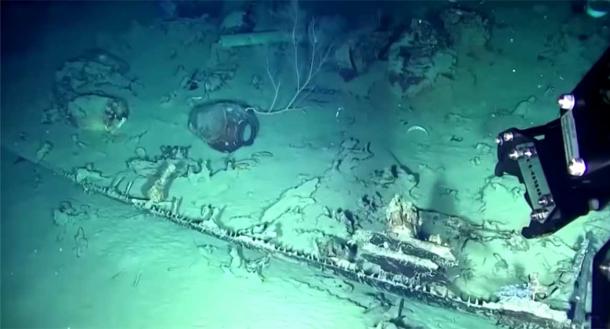
New images of the San Jose wreck site with part of the underwater robot visible. Source: ( Presidency of the Republic of Colombia )
The Real Battle for the San Jose Begins
The Colombian president said plans are currently being made for “sustainable financing mechanisms” to secure future treasure recovery dives. This way, said Duque, “the patrimony” of the ill-fated San Jose will be protected for future archaeological projects.
Before she sank, the San Jose was heading back from the New World to King Philip V, overloaded with around 200 tons of gold, silver and emeralds, which were valued at around 11 million pesos when the San Jose sank. This is why Colombia is not going to give up the San Jose wreck’s treasure without a serious legal battle .
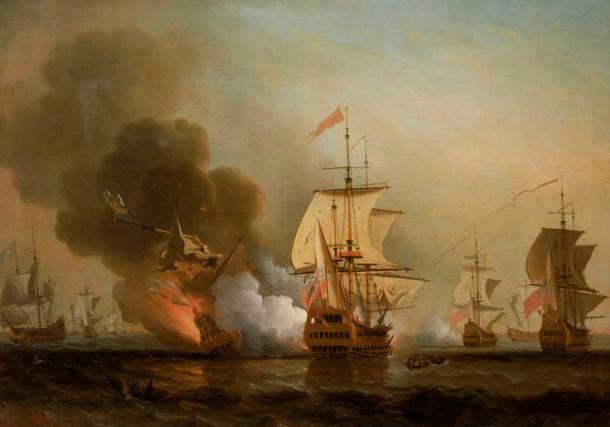
Painting of Charles Wager’s assault off Cartagena in 1708 which ultimately sunk the Spanish San Jose, along with its famed treasure. ( Public domain )
Although discovered in Colombian waters, as a Spanish ship, carrying a 570 Spanish citizens, loaded with cargo from Peru and Panama, several countries have laid claim to the sunken treasure. This has meant that Spain, Peru, and Panama have all lodged legal claims for a share of the 20-million-dollar bounty. The Bolivian indigenous Qhara Qhara nation has also claimed a percentage, claiming that their ancestors were forcibly made to mine the treasure back in the 16th century.
As if it wasn’t complicated enough, the case is actually far more complex. Back in 1981, the Glocca Mora Company (GMC), discovered the wreckage and was promised 35% of the treasure. They then handed over their rights to the American salvage company Sea Search Armada (SSA). In 2013 Colombia passed a law which determined that any sunken ships discovered within Colombian waters were de facto national heritage. This in had the effect of “extinguishing any rights SSA had,” explained ASIS International .
Colombia also claimed that GMC had failed to accurately locate the San Jose wreck, and so hired the Woods Hole Oceanographic Institution (WHOI) in 2015. Meanwhile the case has continued to progress through the court system. Even UNESCO has weighed in by sending a letter to the Colombian Minister of Culture which stated that “the commercial exploitation of Colombia’s cultural heritage goes against the best scientific standards and international ethical principles as laid down especially in the UNESCO Underwater Cultural Heritage Convention.”
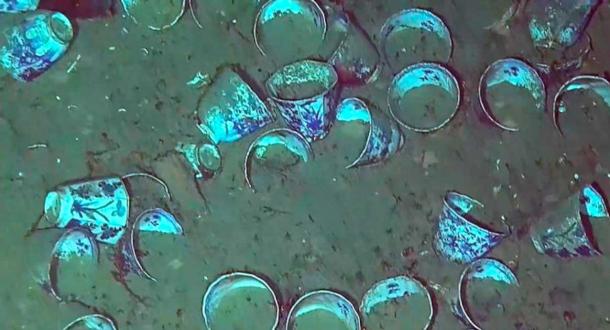
Porcelain cups from a bygone era on the see bed. ( Presidency of the Republic of Colombia )
Reading Between the Lines
As far as Colombia is concerned, the fact that the San Jose sank in Colombian waters is a fortunate windfall since the 2013 law determines that any wrecks become part of the nation’s cultural heritage. This means the treasure discovered within shipwrecks cannot be sold or traded outside Colombia. The nation even plans to build a new museum of shipwrecks in Cartagena featuring some of the treasure recovered from the San Jose wreck.
Now, you see, it makes perfect sense why the president of Colombia never calls the 20 billion hoard a “treasure,” but only ever the “patrimony” of the ship. He knows it’s much, much harder for a foreign country or internal group to get their hands on “national patrimony,” than it is to claim a share of a financial sum associated with treasure. Meanwhile, the precise location of the San Jose shipwreck is being kept under wraps as a state secret.
source: ancient-origins.net








